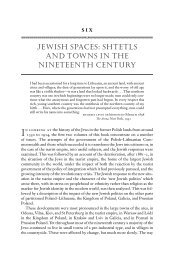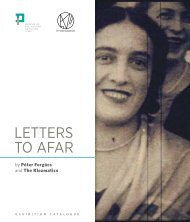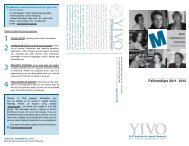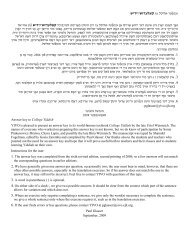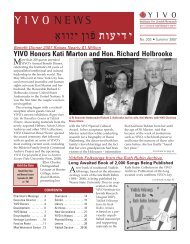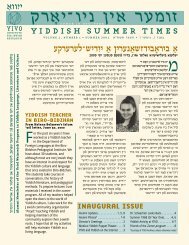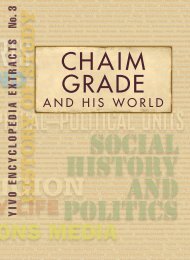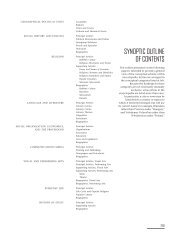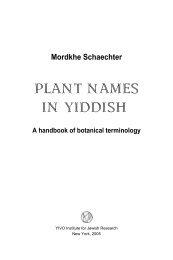You also want an ePaper? Increase the reach of your titles
YUMPU automatically turns print PDFs into web optimized ePapers that Google loves.
S<br />
R<br />
L<br />
Eker, Karol Dresdner, Daniel Ihr, Juliusz<br />
Wit, and critic Izydor Berman. Chwila<br />
also organized literary events and competitions,<br />
among them the literary competition<br />
“Why Do I Love Palestine?” in 1927.<br />
Chwila provided information on Jewish<br />
society in both Poland and Palestine, featuring<br />
Szymon Wolf’s Felietony palestynskie<br />
(Palestinian Feuilletons) and Bernard<br />
Zimmerman’s reports from Palestine.<br />
In 1935, the paper introduced a regular<br />
column on issues in Palestine, edited by<br />
Saul Langnas. The daily featured political,<br />
economic, social, and cultural sections.<br />
In the latter, Adolf Plohn wrote about<br />
music, Hescheles covered the theater, and<br />
Artur Lauterbach dealt with the fine arts.<br />
Special sections catered to university students<br />
(Chwila akademicka, later renamed<br />
Ruch mËodzieÛy [Youth Movement]), and<br />
women (GËos kobiet [Women’s Voice]).<br />
Sections on sports, chess (edited by Julian<br />
Madfes), and satire (edited by Zygmunt<br />
Schorr) appeared along with reports on<br />
court proceedings. Among its supplements<br />
were Chwilka dzieci i mËodzieÛy<br />
(Little Moment for Children and Youth),<br />
edited by Runa Reitmanowa; Dodatek Literacko-Naukowy<br />
(Literary and Scientific<br />
Supplement), edited by Hescheles; Przewodnik<br />
ekonomiczny (Economic Guide); and,<br />
from 1932, Dodatek ilustrowany (Illustrated<br />
Supplement).<br />
Chwila also published translations of<br />
Jewish literature into Polish, including<br />
works by Y. L. Peretz, S. An-ski, Israel<br />
Joshua Singer, Uri Tsevi Grinberg, Ôayim<br />
NaÕman Bialik, Shemu’el Yosef Agnon,<br />
Sha’ul Tshernichowsky, Itsik Manger, and<br />
Sholem Asch, as well as works of world<br />
literature (Joseph Roth was one of the authors<br />
included). Popular literature (e.g.,<br />
popular novels published in installments)<br />
appeared with more elitist writings.<br />
Like other Polish Jewish publications,<br />
Chwila criticized radical assimilation,<br />
supported Jewish national revival, and<br />
called for the building of a Jewish state in<br />
Palestine. At the same time, it stressed the<br />
value of contributions to Polish culture<br />
made by assimilated Jews. One of its recurring<br />
themes was the situation in<br />
higher education, reflecting the concerns<br />
of Jewish students at the University of<br />
Lwów, and the question of the numerus<br />
clausus (enrollment quotas).<br />
The paper devoted more attention than<br />
other dailies to local and regional issues<br />
(e.g., it had a column titled “Z gminy<br />
Ûydowskiej” [From the Jewish Community])<br />
and featured regular news about<br />
communities in the smaller southeast-<br />
ern towns (Chwila Drohobycka and Chwila<br />
Tarnopolska [Drohobycz and Tarnopol<br />
Chwila, respectively]). This local focus<br />
also reflected Chwila’s interest in Galician<br />
Jewish culture; it featured articles about<br />
the region’s towns, luminaries, and Jewish<br />
writers.<br />
• Barbara Ê×tocha, “Chwila: Gazeta Úydów<br />
lwowskich,” Rocznik Lwowski (1995–1996):<br />
63–79; Eugenia Prokop-Janiec, Polish-Jewish<br />
Literature in the Interwar Years, trans. Abe<br />
Shenitzer (Syracuse, N.Y., 2003).<br />
—Eugenia Prokop-Janiec<br />
Translated from Polish by Christina Manetti;<br />
revised by Magda Opalski<br />
CHWOLSON, DANIEL. See Khvol’son,<br />
Daniil Avraamovich.<br />
CILIBI MOISE (1812–1870), author of<br />
adages and aphorisms. Froim Moise,<br />
known in Romanian literature as Cilibi<br />
Moise, was the son of Alexander Sender<br />
Schwartz, a native of Galicia. Illiterate in<br />
Romanian, Moise would dictate his compositions<br />
to printers and sell them in<br />
pamphlets in the market towns of Walachia,<br />
where he was a traveling merchant.<br />
The 14 pamphlets issued as of 1858 included<br />
adages and sayings, maxims,<br />
thoughts, and moral lessons drawn from<br />
the school of life, revealing a picturesque<br />
and lively mixture of popular wisdom,<br />
Balkan humor, and Jewish folklore.<br />
Beyond Cilibi Moise’s words of wisdom,<br />
he presented a philosophy of life that<br />
combined skepticism with serene resignation<br />
to poverty and hardship, and also<br />
demonstrated a critical and ironic overview<br />
of social rules and injustice. He commented<br />
on the manners of his times, as<br />
well as on human nature and the human<br />
condition, with echoes from Ecclesiastes<br />
(“Remember where you come from,<br />
where you stand and where you are<br />
headed to”). Several thoughts are extremely<br />
powerful, though expressed in a<br />
lapidary style: “It is hard for the poor to<br />
live, while it is hard for the rich to die”;<br />
“Time is a stairway: one goes up, another<br />
comes down.” His self-mockery and black<br />
humor derive from Jewish popular origin:<br />
“Moise the Jew keeps a bell on his table;<br />
when he rings once, he brings water himself<br />
as he does not have a servant”; “One<br />
day Cilibi Moise suffered a great embarrassment:<br />
thieves broke into his house at<br />
night and didn’t find anything”; “Cilibi<br />
Moise has been asking poverty for several<br />
years to get out of his house at least for as<br />
long as it takes him to get dressed.”<br />
Encouraged by Moses Gaster, the folklorist<br />
Moses Schwarzfeld collected and<br />
edited a posthumous book of Cilibi<br />
Moise’s sayings, titled Practica ãi apropourile<br />
lui Cilibi Moise vestitul din ìara<br />
Româneascç (The Practice and Sayings of<br />
the Renowned Cilibi Moise from Walachia;<br />
1883). Cilibi Moise became, mostly<br />
after his death, a legendary figure, an embodiment<br />
of popular wisdom and humor,<br />
nostalgically evoked by a great Romanian<br />
writer (Ion Luca Caragiale) or turned into<br />
a character in several plays. He is considered<br />
to be the first Jewish author of literary<br />
pieces, naive though captivating, and<br />
enjoyed by both Romanian readers and<br />
the Jewish public. Rightfully considered<br />
an “oral genius,” his style set the stage for<br />
Romanian Jewish writers of the modern<br />
age.<br />
• ìicu Goldstein, “Cilibi Moise vestitul din<br />
ìara Româneascç”, in Practica ãi apropourile lui<br />
Cilibi Moise vestitul în ìara Româneascç,<br />
pp. 115–136 (Bucharest, 2000); A. B. Yoffe, Be-<br />
Sadot zarim: Sofrim yehudim be-Romanyah,<br />
1880–1940 (Tel Aviv, 996), pp. 33–40.<br />
—Leon Volovici<br />
Translated from Romanian by Anca Mircea<br />
CINEMA. Perhaps because the birth of<br />
cinema in the late nineteenth century coincides<br />
with the migration of Jews from<br />
the Pale of Settlement to the cities of Eastern<br />
Europe, newly urbanized Jews were<br />
prominent in the development of Eastern<br />
European cinema—if only intermittently<br />
as Jewish artists addressing Jewish themes<br />
or a Jewish public.<br />
Early <strong>Cinema</strong><br />
While motion picture technology was<br />
first exported to Eastern Europe around<br />
the turn of the twentieth century, limited<br />
production did not begin for another<br />
decade. Not until 1911, when A. M. Smolenskii’s<br />
“singing” troupe was reported<br />
touring the Pale of Settlement, providing<br />
silent movies with live Yiddish-language<br />
accompaniment—a hybrid form known<br />
in Russian as kino-deklamatsiia (talking<br />
pictures)—does the record show indigenous<br />
motion picture entertainment<br />
aimed at a Russian Jewish audience. The<br />
same year, Pathé Frères’ Moscow released<br />
the highly popular L’khaym (To Life), a<br />
bucolic tragedy of shtetl life, while Jewish<br />
producer Aleksander Hertz, who left<br />
Pathé in 1910 to found Poland’s first indigenous<br />
production company, Sfinks,<br />
adapted Eliza Orzeszkowa’s Meir Ezofewicz,<br />
in which an idealistic young Jew revolts<br />
against clerical constraints to join<br />
the struggle for Polish freedom.<br />
CINEMA 331
Anecdotal information suggests that<br />
many of Russia’s pioneer movie exhibitors<br />
and distributors were Jews; Jewish entrepreneurs<br />
were even more prominent in<br />
the early Polish and Hungarian cinemas.<br />
Between 1911 and 1913, approximately<br />
one-third of all Polish films were of Yiddish<br />
plays. The SiËa firm, owned by Warsaw<br />
exhibitor Mordka Towbin, filmed a<br />
number of productions staged by the<br />
Kaminski troupe—as did its successor<br />
Kosmofilm, Poland’s most important production<br />
company before World War I,<br />
founded by Towbin’s onetime partner<br />
Samuel Ginzberg and film-lab owner<br />
Henryk Finkelstein. Interest in the Yiddish<br />
stage extended to more established<br />
studios: in 1912, Pathé Frères Moscow<br />
adapted Sholem Asch’s Got fun nekome<br />
(God of Vengeance) and Moscow Gaumont<br />
produced Jacob Gordin’s Mirele<br />
Efros. In Riga, another center of Jewish<br />
filmmaking, the S. Mintus Company released<br />
at least seven productions made<br />
with Yiddish theatrical troupes.<br />
The most widely distributed Jewish<br />
film, however, was produced by the Mizrakh<br />
company in Odessa: Zhizn’ evreev v<br />
Palestine (The Life of Jews in Palestine)<br />
had its world premiere at the Eleventh Zionist<br />
Congress in Vienna before playing<br />
some 30 separate engagements throughout<br />
Europe and Russia; its extraordinary<br />
success inspired similar feature-length<br />
documentaries produced in Poland, one<br />
by Kosmofilm, and in Czechoslovakia.<br />
World War I and After<br />
Although World War I disrupted film<br />
production in the Russian Empire, Hungarian<br />
cinema boomed while French, Italian,<br />
and American imports were unavailable.<br />
Hungarian Jews deeply involved in<br />
the nation’s cultural life—particularly the<br />
nascent motion picture industry—included<br />
Mihály Kertész (later Michael<br />
Curtiz), who directed the first Hungarian<br />
feature film, and Sandor Korda (Alexander<br />
Korda), the leading Hungarian producer.<br />
Several Jewish-themed films were produced<br />
during this period, all with literary<br />
antecedents: Adolf Mérei’s Simon Judit<br />
(Judith Simon; 1915), based on the nineteenth-century<br />
ballad by Jewish poet<br />
József Kiss; Korda’s Lyon Lea (1915),<br />
adapted from Sándor Bródy’s play (later<br />
filmed in the United States as Surrender);<br />
Jenö Illés’ Szulamit (1916) from Avrom<br />
Goldfadn’s Yiddish operetta; Kertesz’s Az<br />
árendás zsidó (The Jewish Tenant Farmer;<br />
1917), from the folk drama by Szidor<br />
Bator, and Béla Balogh’s Israel (1918),<br />
332 CINEMA<br />
from Henry Bernstein’s play. Korda,<br />
Kertesz, and Balogh were all involved in<br />
the nationalized film industry of the<br />
short-lived Council Republic, and all<br />
three left Hungary after it fell in 1918.<br />
After the overthrow of the tsar in 1917,<br />
Mizrakh contributed to a brief revival in<br />
Russia of Jewish-themed pictures that included<br />
a dramatic reconstruction of the<br />
Beilis blood libel case, a film version of<br />
Evgenii Chirikov’s play Evrei (Jews), and<br />
several adaptations from Yiddish literature<br />
directed by Aleksandr Arkatov. The<br />
October revolution and ensuing Civil<br />
War again disrupted Russian filmmaking,<br />
although several short propaganda films<br />
produced in 1919 by the Mos-Kino-<br />
Komitet were specifically directed at Jewish<br />
audiences.<br />
Polish film production did not return<br />
to prewar levels until the early 1920s. In<br />
1921, Sfinks released Tajemnice Nalewek<br />
(Secrets of the Nalewki), which exposed<br />
poverty in Warsaw’s Jewish district. Òmierñ<br />
za Ûycie (Death Instead of Life; 1924) told<br />
the tale of a Jewish innkeeper’s son who,<br />
thanks to the friendship of a Polish<br />
prince, blossomed into a great national<br />
poet. More significant were the three<br />
movies produced by Leo Forbert, the<br />
owner of Warsaw’s largest photo lab, between<br />
1924 and 1929. Tkies kaf (The<br />
Handshake), the first and most successful,<br />
starred Ester-Rokhl Kaminska and her<br />
daughter Ida; it was followed in 1925 by<br />
Jeden z 36 (One of the 36) and an ambitious,<br />
ill-fated adaptation of Yosef<br />
Opatoshu’s novel Poylishe velder (The Polish<br />
Woods; 1929).<br />
The new Soviet film industry made the<br />
most programmatic attempt to develop<br />
a credible Jewish cinema. In 1925, a year<br />
after the state motion picture agency<br />
Sovkino was established, the Soviet<br />
Union’s two major Jewish theaters were<br />
involved in film production. Aleksandr<br />
Granovskii, the founder of the Moscow<br />
GOSET, directed Solomon Mikhoels in<br />
Evreiskoe schast’e (Yidishe glikn; Jewish<br />
Luck), which drew on Sholem Aleichem’s<br />
Menakhem Mendl stories and featured<br />
inter-titles written by Isaac Babel, while<br />
Sovkino invited members of the Hebrewlanguage<br />
Habimah to appear in the adaptation<br />
of Sholem Aleichem’s novel Der<br />
mabl (The Deluge).<br />
Subsequent Jewish-themed films were<br />
made under the auspices of the Ukrainian<br />
national studio VUFKU. These included<br />
two projects developed by Babel—Benia<br />
Krik (1926), based on his stories of<br />
Odessa’s Jewish underworld, and Bluzhdaiushchie<br />
zvezdy (Wandering Stars;<br />
1927), from Sholem Aleichem’s novel of<br />
the Yiddish theater Blonzhende shtern.<br />
Sholem Aleichem’s work also provided<br />
the theme for Grigorii Gricher-Cherikover’s<br />
Skvoz slezy (Through Tears; 1928).<br />
Given the substantial Jewish population<br />
of Ukrainian cities, VUFKU’s commit-<br />
Solomon Mikhoels (center) and other actors in Yidishe glikn (Jewish Luck), directed by Aleksandr<br />
Granovskii, USSR, 1925. (YIVO)<br />
MS3<br />
S<br />
R<br />
L
S<br />
R<br />
L<br />
ment to these films was as much commercial<br />
as political. Such productions were<br />
made through 1930, becoming increasingly<br />
tendentious in their emphasis on<br />
social divisions and their idealization of<br />
Jewish collective farmers. In addition,<br />
Sovkino produced several features between<br />
1929 and 1931 in the service of an<br />
official campaign against antisemitism.<br />
At the same time, Grigorii Roshal’, who<br />
directed a politically risky film about the<br />
Bundist hero Hirsh Lekert, was unique in<br />
his attempt to portray specifically Jewish<br />
revolutionary heroism.<br />
From the silent period through World<br />
War II, a significant number of Soviet directors<br />
were Jews. In addition to Roshal’,<br />
these include Mark Donskoi, Fridrikh<br />
Ermler, Iosif Kheifits, Grigorii Kozintsev,<br />
Iurii Raizman, Mikhail Romm, Abram<br />
Room, Esfir Shub, Leonid Trauberg, and<br />
Dziga Vertov. Also prominent were<br />
screenwriter Natan Zarkhi (whose scripts<br />
include those for V. I. Pudovkin’s silent<br />
classics Mat’ (Mother) and Konets Sankt-<br />
Peterburga (The End of St. Petersburg),<br />
film composer Isaak Dunaevskii, and documentary<br />
filmmaker Roman Karmen. Sergei<br />
Eisenstein, the most celebrated and<br />
influential Soviet director, was of Jewish<br />
descent; although his mother was Russian<br />
Orthodox and his German Jewish paternal<br />
grandfather had been baptized, the<br />
director was considered by many to be a<br />
Jew and, during World War II, served as a<br />
spokesman for the Jewish Anti-Fascist<br />
League.<br />
As Soviet policies regarding national<br />
minorities shifted in the early 1930s, Jewish<br />
themes disappeared altogether, with<br />
the remarkable exception of Mikhail<br />
Dubson’s 1935 Granitsa (Border); the<br />
1936 Iskateli schast’ia (Seekers of Happiness),<br />
which marked the opening of<br />
Birobidzhan to foreign settlers; and two<br />
antifascist features, Professor Mamlok<br />
(1938) and Sem’ia Oppengeim (The Family<br />
Oppenheim; 1939).<br />
Yiddish Talkies<br />
The first sound film made by the Belorussian<br />
studio Belgoskino, a short subject<br />
released in 1931, featured traditional<br />
Belorussian, Polish, and Yiddish songs. In<br />
1932, the studio went a step further with<br />
Nosn Beker fort aheym (The Return of Nathan<br />
Becker), the first—and, only—Soviet<br />
Yiddish talking picture, written by Perets<br />
Markish and starring Mikhoels.<br />
Yiddish talkies had been produced in<br />
the United States as early as 1929; although<br />
these were distributed in Poland,<br />
the first Polish productions were not<br />
Shooting the film Freylekhe kabtsonim (Jolly Paupers), starring Zygmunt Turkow, his daughter<br />
Ruth Turkow, Shimon Dzigan, and Yisroel Shumacher, Poland, 1937. (YIVO)<br />
made until 1935. The melodrama Al khet<br />
(I Have Sinned) directed by Aleksander<br />
Marten, and Mir kumen on (We’re On Our<br />
Way), a feature documentary by Aleksander<br />
Ford on the Vladimir Medem Sanatorium<br />
for tubercular children, were<br />
both produced by Shaul Goskind, coowner<br />
of the Warsaw film laboratory,<br />
Sektor. In 1936, the Polish-born Yiddish<br />
actor Joseph Green returned to make Yidl<br />
mitn fidl (Yiddle with a Fiddle), the first<br />
of four Yiddish talkies, all of which featured<br />
American stars but were produced<br />
with Polish supporting players and technicians.<br />
One of the three top-grossing<br />
Polish movies of 1936, Yidl was the<br />
first international Yiddish hit—released<br />
throughout Western Europe as well as<br />
South Africa, Australia, and (dubbed into<br />
Hebrew) Palestine.<br />
Poland’s nascent Yiddish cinema benefited<br />
from changes in the national film<br />
policy. As the ticket tax was reduced on<br />
Polish films and increased for foreign<br />
ones, output rose dramatically. Four of<br />
the 23 Polish films made in 1937 were<br />
Yiddish talkies: Green’s Der purimshpiler<br />
(The Jester), Freylekhe kabtsonim (Jolly<br />
Paupers), starring the popular comedians<br />
Dzigan and Schumacher, a sound remake<br />
of Tkies kaf, and Der dibek (The Dybbuk),<br />
directed by MichaË Waszyáski. The latter<br />
two were produced by major studios, Leo-<br />
Film and Sfinx, and shown with Polish<br />
subtitles in the principal Warsaw cinemas.<br />
A final three Yiddish talkies were<br />
produced in 1938, two by Green (Mamele<br />
[Little Mother] and A brivele der mamen [A<br />
Little Letter to Mother]) and Marten’s On<br />
a heym (Without a Home).<br />
Yiddish talkies were not only comparable<br />
to those of the Polish mainstream but<br />
were produced by the same people. Indeed,<br />
the most successful Yiddish talkies<br />
were directed by established industry figures,<br />
including Waszyáski, Ford, Henryk<br />
Szaro, Jan Nowina-Przybina, Leon Trystan,<br />
and Konrad Tom (all, save Nowina-<br />
Przybina, Jews), while Marten was a refugee<br />
from the German film industry. As<br />
the Polish movie industries received Jew-<br />
Lili Liliana in Der dibek (The Dybbuk),<br />
directed by MichaË Waszyáski, Poland, 1937.<br />
(YIVO)<br />
CINEMA 333
ish émigrés, however, Hungary’s newly<br />
restrictive laws, implemented in 1938,<br />
prevented Jews—highly represented as<br />
filmmakers—from working. These included<br />
the industry’s three leading directors,<br />
István Székely, Béla Gaál, and Viktor<br />
Gertler, as well as the popular comedian<br />
Gyula Kabos, whose character humor was<br />
understood as typically Jewish.<br />
Post–World War II Period<br />
Yiddish-language cinema, which depended<br />
on two markets—one in America,<br />
the other in Poland—was dealt a serious<br />
blow by the outbreak of World War II and<br />
a fatal one by the murder of Polish Jewry.<br />
Nevertheless, beginning in 1946, Shaul<br />
Goskind produced a series of Yiddish<br />
newsreels on postwar Jewish life. According<br />
to Goskind’s director Natan Gross,<br />
these short documentaries, screened as<br />
special shows attended almost entirely by<br />
Jews, were the first films made in Poland<br />
after the war.<br />
In 1947 and 1948, Gross and Goskind<br />
made two ambitious features, Mir lebngeblibene<br />
(We the Living Remnant) and<br />
Undzere kinder (Our Children). Neither<br />
would be shown in Poland although two<br />
movies released in 1948 did address the<br />
fate of Polish Jewry: Wanda Jakubowska’s<br />
Ostatni etap (The Last Stage; 1948) based<br />
on her own experiences in Auschwitz,<br />
and Aleksander Ford’s Ulica graniczna<br />
(Border Street; 1948). Ulica graniczna,<br />
which has as its climax the Warsaw<br />
ghetto uprising, was held for release for<br />
over a year; so was the most notable<br />
Czechoslovakian representation of the<br />
Holocaust, Alfred Radok’s 1948 Daleká<br />
cesta (Distant Journey), which focuses on<br />
a Jewish doctor who briefly forestalls her<br />
deportation to Terezín by marrying a gentile<br />
colleague. These films were victims of<br />
the upsurge of government antisemitism<br />
within the Soviet Union. Among Soviet<br />
directors, Trauberg and Vertov were particular<br />
targets of the anticosmopolitan<br />
campaign of the late 1940s and early<br />
1950s, as was Sergei Iuktevich who, like<br />
Eisenstein, was identified as a Jew. (Eisenstein<br />
was under attack when he died in<br />
1948.) The cosmopolitans were accused<br />
of promoting an international cinema<br />
culture and of “groveling” before Western<br />
films. Virtually all Jewish directors were<br />
stigmatized; some, including Kozintsev,<br />
Romm, and Room, compensated by making<br />
egregiously conformist and anti-<br />
Western movies.<br />
Jewish themes were slow to reemerge<br />
on the Soviet screen. In 1966, Mikhail<br />
Kulik struggled in vain to make a movie<br />
334 CINEMA<br />
about the Vilna Ghetto. Aleksandr<br />
Askol’dov’s 1967 Kommisar, which drew<br />
on Jewish authors Isaac Babel and Vasilii<br />
Grossman as well as the shtetl films of the<br />
1920s, was banned for more than two decades.<br />
While many of the leading Polish directors<br />
of the 1950s were Jews—Ford, Jerzy<br />
Hoffman, Janusz Morgenstern, Andrzej<br />
Munk, and Roman Polanski among<br />
them—few movies featured Jewish protagonists.<br />
The two exceptions were both<br />
lavish period pieces, Wojciech Has’s 1974<br />
adaptation of Bruno Schultz’s Sanatorium<br />
pod klepsydra (Sanatorium under the<br />
Hourglass) and Jerzy Kawalerowicz’s 1981<br />
Austeria. Andrzej Wajda, a gentile, was<br />
the only major Polish director to consistently<br />
represent Polish Jews, notably<br />
in his Warsaw ghetto dramas, Samson<br />
(1961), Korczak (1990), and Wielki tydzien<br />
(Holy Week; 1995).<br />
In the mid-1960s, Daleká cesta was rediscovered<br />
by the Czech “new wave” and<br />
the persecution of Czech Jews used as a<br />
metaphor for the postwar fate of the<br />
Czech nation. After directing Transport z<br />
raje (Transport from Paradise; 1963) from<br />
Arnošt Lustig’s Terezín novel, Zbynõk<br />
Brynych universalized the plight of a Jewish<br />
family under the Nazis in ...a páty<br />
jezdec je Strach (...TheFifth Horseman Is<br />
Fear; 1964). Jan Nõmec’s Démanty noci<br />
(Diamonds of the Night; 1965), based on<br />
Lustig’s story of two Jewish boys who escape<br />
from a transport, similarly aspired to<br />
universalized Jewish themes. The tendency’s<br />
most celebrated example, Obchod<br />
na korze (The Shop on Main Street; 1965)<br />
by Jan Kadár and Elmar Klos, starring Ida<br />
Kaminska, won an Academy Award for<br />
best foreign feature; further instances are<br />
Antonin Moskalyk’s 1967 adaptation of<br />
Lustig’s Dita Saxová and Juraj Herz’s<br />
Spalovaó mrtvol (The Cremator of Corpses;<br />
1968). As if to validate their larger antitotalitarian<br />
readings, all of these were<br />
shelved and/or vilified in Czechoslovakia<br />
after the 1968 Warsaw Pact invasion.<br />
Unlike Poland or Czechoslovakia, Hungary<br />
produced no postwar representation<br />
of Jewish wartime suffering, although the<br />
fate of Hungarian Jewry was acknowledged<br />
in a number of movies, including<br />
Félix Máriássy’s 1955 Budapesti tavasz<br />
(Springtime in Budapest) and János<br />
Herskó’s 1963 Párbsezéd (Dialogue). A few<br />
discreetly Jewish characters appeared in<br />
the work of István Szabó and Sándor Simó<br />
but Jews were as underrepresented on the<br />
screen as they were prominent behind<br />
the camera. Indeed, the lead in introduc-<br />
ing Jewish subject matter was taken by<br />
gentiles. Miklós Jancsó, whose extended<br />
family included Yiddish-speaking Transylvanian<br />
Jews, made a number of poetic<br />
documentaries meditating on the destruction<br />
of Jewish life in Hungary. Imre<br />
Gyöngyössy and Barna Karbay’s Jób<br />
lázadása (The Revolt of Job; 1983) was the<br />
first Hungarian movie to center on the<br />
wartime deportation of the Jews.<br />
After Communism<br />
Beginning in the mid-1980s and gaining<br />
momentum with the dissolution of<br />
Communism, Jews repopulated the East<br />
European cinema, albeit almost entirely<br />
as historical figures. Juraj Herz, who<br />
had been deported to Ravensbruck as a<br />
child, directed a second Holocaust feature<br />
Zastihla mì noc (Night Caught Up<br />
with Me; 1986). Veteran filmmaker Karel<br />
Kachyûa made three pictures on the history<br />
of Czech Jews: Smrt krásnych srncï<br />
(The Death of the Beautiful Roebuck;<br />
1986), based on the autobiographical novella<br />
by Jewish journalist Ota Pavel;<br />
Poslední motýl (The Last Butterfly; 1990),<br />
about Jewish children in Terezín; and<br />
Hanele (1999), adapted from the novella<br />
by Ivan Olbracht. The drama of sheltering<br />
a Jew during the Nazi occupation, a<br />
theme previously treated in Budapesti<br />
tavasz and by Czech director Ji֒ Weiss in<br />
his Romeo, Julie a tma (Romeo, Juliet and<br />
Darkness; 1959), returned in Wajda’s<br />
Wielki tydzieá, Jan Hrebejk’s Musíme si<br />
pomahat (Divided We Fall; 2000), and Jan-<br />
Jakub Kolski’s Daleko od okna (Far from<br />
the Window; 2000).<br />
In Hungary, a late twentieth-century resurgence<br />
of Jewish subject matter was<br />
largely associated with Jewish filmmakers.<br />
Gyula Gazdag’s 1985 Auschwitz<br />
documentary Társasutszás (Package Tour)<br />
was followed by Tutajosok (Memoirs of<br />
a River; 1989), in which Judit Elek addressed<br />
the taboo subject of the Tiszaeszlár<br />
trial. Andras Jeles dramatized<br />
the Jewish deportations in Senkiföldje<br />
(Why Wasn’t He There; 1993); Herskó returned<br />
to Hungary in 1995 to make the<br />
documentary A Kenyereslány Balladája<br />
(The Ballad of the Bread Girl), in which<br />
he revisited the sites where he had been<br />
sent as a Jewish slave-laborer. A related<br />
trend involves the reworking of amateur<br />
16mm movies shot by Hungarian Jews<br />
in the 1930s and 1940s, most notably in<br />
the movies made by video artist Pétér<br />
Forgacs.<br />
The dissolution of the Soviet Union<br />
brought a brief flurry of adaptations from<br />
Babel and Sholem Aleichem—three ver-<br />
MS3<br />
S<br />
R<br />
L
S<br />
R<br />
L<br />
sions of Babel’s Benia Krik stories were released<br />
in 1990. There have also been a<br />
number of largely undistinguished documentaries<br />
on the Soviet Yiddish culture of<br />
the 1920s and 1930s and its post–World<br />
War II destruction but no sustained examination<br />
of Russian, Ukrainian, or Soviet<br />
Jewish life.<br />
[See also the biographies of Balázs, Ford,<br />
Kozintsev, Romm, Trauberg, and Vertov.]<br />
APPENDIX: JEWISH FILM<br />
PERSONALITIES<br />
Arkatov, Aleksandr (1889–1961), film<br />
director. Russia’s first maker of Jewish<br />
films, Arkatov (Mogilevskii) was initially<br />
employed by Pathé Frères Moscow; later<br />
he directed a quartet of literary adaptations<br />
in Odessa: Kantonisti (Cantonists;<br />
1917), based on Grigorii Bogrov’s novel<br />
Zapiski evreia (Notes of a Jew); Der blutiker<br />
shpas (The Bloody Oath; 1917) and Ven<br />
Ikh Bin Rotshild (If I Were Rothschild;<br />
1918), both adapted from Sholem Aleichem’s<br />
stories; and Orupgeloste oygen<br />
(Downcast Eyes) from Y. L. Peretz. After<br />
directing for the Mos-Kino-Komitet, Arkatov<br />
came to the United States where his<br />
career was confined largely to industrial<br />
films.<br />
Bojm, Henryk (Yekhiel; 1890s–1944?),<br />
screenwriter. The catalytic figure in Poland’s<br />
silent Jewish cinema, Bojm rebelled<br />
against but drew upon his Hasidic upbringing,<br />
writing three screenplays for<br />
producer Leo Forbert in the 1920s. A<br />
fourth, adapted from Sholem Asch’s<br />
Motke ganev, was never realized. Bojm was<br />
also a photojournalist for the Jewish<br />
press. He died in the Warsaw Ghetto.<br />
Elek, Judit (1937– ), director. An original<br />
member of Hungary’s experimental<br />
Béla Balázs Studio, Elek was rooted in<br />
documentary but had an international<br />
hit with her first feature Sziget a Szárazföldön<br />
(The Lady From Constantinople;<br />
1969). After exploring a traumatic experience<br />
in Hungarian Jewish history with<br />
Tutajosok (Memoirs of a River; 1989), she<br />
recounted a Jewish girl’s coming of age in<br />
the early 1950s in Ébredés (Awakening;<br />
1994), and has since produced documentary<br />
portraits of Elie Wiesel (1995) and<br />
Holocaust survivor Ernö Fisch (1999).<br />
German, Aleksei (1938– ), director.<br />
German, son of Stalin-era writer Yuri German,<br />
was the most highly regarded<br />
filmmaker who emerged in the late Soviet<br />
period despite the fact that (or because)<br />
virtually all his features were<br />
shelved. German’s masterpiece Moy drug<br />
Ivan Lapshin (My Friend Ivan Lapshin;<br />
completed in 1982 but not shown for<br />
three years) used one of his father’s novels<br />
to comment on the illusions of<br />
the 1930s; his even more atmospheric<br />
postcommunist follow-up, Khrustalyov,<br />
mashinu! (Khrustalyov, My Car!; 1998), is<br />
a frenzied phantasmagorical account of<br />
Stalin’s final days from the perspective of<br />
a military doctor whose family, like the<br />
filmmaker’s, is part Jewish.<br />
Goskind, Shaul (1907–2003), producer.<br />
A key figure in Polish Jewish film<br />
culture, Goskind founded the Yiddish<br />
film journal Film velt in 1928, operated a<br />
Warsaw film lab throughout the 1930s<br />
and produced the first Polish Yiddish<br />
talkie, Al khet (1935). In the late 1930s, he<br />
and his brother Yitshak documented Jewish<br />
life in Poland with a series of brief<br />
newsreels; Goskind revived his production<br />
company after World War II, making<br />
Yiddish documentaries and features before<br />
immigrating to Israel in 1950.<br />
Kadár, Ján (1918–1979), director. Born<br />
in Hungary but raised in Czechoslovakia,<br />
Kadár had his film studies interrupted by<br />
World War II and survived several Nazi<br />
concentration camps. After liberation, he<br />
collaborated with Elmar Klos on a number<br />
of documentaries and features, including<br />
Obchod na korze (The Shop on<br />
Main Street; 1965). Kadár left Czechoslovakia<br />
in 1968; his subsequent films included<br />
Angel Levine (1970), made in the<br />
United States from the story by Bernard<br />
Malamud.<br />
Munk, Andrzej (1921–1961), director.<br />
One of the most talented members of the<br />
Polish new wave, Munk graduated from<br />
high school the summer World War II<br />
broke out; he fought in the underground<br />
and, after the war, enrolled in the Êódß<br />
film school. Munk’s features are characterized<br />
by their ironic, formally adventurous<br />
treatment of Polish history. He died<br />
in a car crash while shooting PasaÛerka<br />
(Passenger), an account of concentration<br />
camp survivors.<br />
Norstein, Iurii (1941– ), animator.<br />
Deeply influenced by the art of the Soviet<br />
avant-garde and the writings of Sergei<br />
Eisenstein, Norstein emerged in the<br />
1970s as one of the world’s most innovative<br />
makers of animated films. His independence<br />
resulted in numerous clashes<br />
with the Communist cultural authorities<br />
although he has since been recognized<br />
among Russia’s leading artists.<br />
Room, Abram (1894–1976), director.<br />
Room had worked at a Vilna Yiddish theater,<br />
as well as with V. I. Meyerhold, before<br />
directing the 1925 short Evrei na<br />
zemle (Jews on the Land), from a script<br />
by Vladimir Mayakovsky and Viktor<br />
Shklovskii. His second feature, Tret’ia meschchanskaia<br />
(translated as Bed and Sofa;<br />
1927), also by Shklovskii, is a classic comedy;<br />
Room directed the first Soviet sound<br />
feature, Plan velikikh rabot (Plan for Great<br />
Works; 1930). Political difficulties in the<br />
early 1930s made him increasingly conformist.<br />
Roshal’, Grigorii (1899–1983), director.<br />
A onetime Habimah stage manager,<br />
Roshal’ broke into filmmaking in the late<br />
1920s. His 1928 Ego prevoskhoditel’stvo<br />
(His Excellency) adapted the story of<br />
Bundist hero Hirsh Lekert; Chelovek iz<br />
mestechka (A Man from the Shtetl), made<br />
for VUFKU in 1930, was another evocation<br />
of Jewish revolutionary martyrdom.<br />
Roshal’s career spanned 40 years; among<br />
his many literary adaptations was Sem’ia<br />
Oppengeim (The Family Oppenheim;<br />
1939), from Lion Feuchtwanger’s novel,<br />
with Solomon Mikhoels as a persecuted<br />
German Jew.<br />
Shub, Esfir (1894–1959), editor. An associate<br />
of Soviet avant-garde artists, Shub<br />
was hired in 1922 to recut and retitle foreign<br />
films for Soviet consumption. With<br />
Padenie dinastii Romanovykh (Fall of the<br />
Romanov Dynasty; 1927), Shub invented<br />
a new form of documentary that took<br />
newsreel footage as its raw material. Her<br />
other compilation films concerned the<br />
Spanish Civil War and the history of Soviet<br />
cinema.<br />
Szabó, Istvan (1938– ), director. Szabó<br />
is Hungary’s most internationally renowned<br />
filmmaker, having won an Academy<br />
Award for his 1981 Mephisto. The son<br />
of a Budapest doctor, he experienced as a<br />
child the wartime suffering of the city’s<br />
Jews. Many of his movies have autobiographical<br />
elements, including Apa (Father;<br />
1966), Tüzoltó utca 25 (25 Fireman<br />
Street; 1973), and Bizalom (Confidence;<br />
1979); the epic Sunshine (2000) refracts<br />
the story of twentieth-century Hungary<br />
through three generations of Budapest<br />
Jews.<br />
Waszyáski, MichaË (1904–1965), director.<br />
Born in Volhynia, Waszyáski<br />
(Wachs) went to Warsaw in the late 1920s<br />
by way of Berlin. In addition to Der dibek,<br />
he directed 40 films during the 1930s,<br />
working in almost every genre—melodra-<br />
CINEMA 335<br />
MS3
mas, musicals, romantic fantasies, farces,<br />
military films, and adventure films.<br />
Waszyáski survived the war in the Soviet<br />
Union, then settled in Italy where,<br />
among other activities, he assisted Orson<br />
Welles. His Variety obituary lists him as<br />
Prince Michael Waszynski.<br />
Weiss, Ji÷í (1913–2004), director and<br />
screenwriter. The son of a Jewish industrialist,<br />
Weiss was an established social<br />
documentarian when he left Prague for<br />
London in 1938; after World War II he<br />
became one of Czechoslovakia’s leading<br />
filmmakers. His 1959 Romeo, Julie a tma<br />
(Romeo, Juliet and Darkness), in which a<br />
Jewish girl is sheltered by a Czech schoolmate,<br />
was an international success. Weiss<br />
left Czechoslovakia in 1968 but returned<br />
in 1989 to film the quasi-autobiographical<br />
Martha und Ich (Martha and I).<br />
• Barbara Armatys, Leszek Armatys, and<br />
WiesËaw Stradomski, Historia filmu polskiego,<br />
vol. 2, 1930–1939 (Warsaw, 1988); WËadysËaw<br />
Banaszkiewicz and Witold Witczak, Historia<br />
filmu polskiego, vol. 1, 1895–1929 (Warsaw,<br />
1989); Boris Berest, History of the Ukrainian<br />
336 CIRCUMCISION<br />
<strong>Cinema</strong> (New York, 1962); John Cunningham,<br />
Hungarian <strong>Cinema</strong>: From Coffee House to Multiplex<br />
(London, 2004); Judith N. Goldberg,<br />
Laughter through Tears: The Yiddish <strong>Cinema</strong><br />
(Rutherford, N.J., 1983); Eric A. Goldman, Visions,<br />
Images, and Dreams: Yiddish Film Past<br />
and Present (Ann Arbor, 1983); Natan Gross,<br />
Toldot ha-kolno‘a ha-yehudi be-Polin, 1910–<br />
1950 (Jerusalem, 1989/90); Peter Hames, The<br />
Czechoslovak New Wave (Berkeley, 1985); Joshua<br />
Francis Hirsch, Afterimage: Film, Trauma,<br />
and the Holocaust (Philadelphia, 2004); J.<br />
Hoberman, Bridge of Light: Yiddish Film between<br />
Two Worlds (New York, 1991); Dina<br />
Iordanova, <strong>Cinema</strong> of the Other Europe: The Industry<br />
and Artistry of East Central European Film<br />
(London, 2003); Peter Kenez, <strong>Cinema</strong> and Soviet<br />
Society, 1917–1953 (Cambridge, 1992); Jay<br />
Leyda, Kino: A History of the Russian and Soviet<br />
Film (New York, 1960); Antonín J. Liehm,<br />
Closely Watched Films: The Czechoslovak Experience<br />
(White Plains, N.Y., 1974); Mira Liehm<br />
and Antonín J. Liehm, The Most Important Art:<br />
East European Film after 1945 (Berkeley, 1977);<br />
David Matis, “Tsu der geshikhte fun yidishn<br />
film,” IKUF-almanak (1961): 439–465; Boles-<br />
Ëaw MichaËek and Frank Turaj, The Modern<br />
<strong>Cinema</strong> of Poland (Bloomington, Ind., 1988);<br />
István Nemeskürty, Word and Image: History<br />
of the Hungarian <strong>Cinema</strong>, 2nd enl. ed. (Budapest,<br />
1974).<br />
—J. Hoberman<br />
CIRCUMCISION. Popular customs and<br />
practices regarding circumcision (Yid.,<br />
bris; Heb., berit milah) seem to have been<br />
fairly consistent within the East European<br />
Jewish community, both Hasidic and<br />
Misnagdic, although there were some regional<br />
variations as to details. Through<br />
out the days leading up to the bris, care<br />
was taken to prevent the demon Lilith<br />
from taking the child: schoolboys were<br />
brought to recite the Shema‘ prayer every<br />
night (for which they were rewarded with<br />
sweets), and amulets were placed in the<br />
room with the child. The night before the<br />
ceremony was to take place, a special vigil<br />
(vakhtnakht) was kept. Candles were lit<br />
throughout the house. After a special<br />
meal (se‘udah), the men present recited<br />
psalms and studied Torah until midnight.<br />
The ritual circumciser (mohel) who was to<br />
perform the ceremony would also be<br />
present and would sometimes leave his<br />
Rosh Hashanah card depicting a circumcision ceremony (Yid., bris; Heb., berit milah). The fruits on the “tree of life” are labeled (left to right), “luck,”<br />
“life,” and “joy,” and the Yiddish verse reads: “A child, boy is born / May he have happiness and live long! / A child, a joy, sugar-sweet / Today was his<br />
bris.” Published by Verlag Central, Warsaw. (YIVO)<br />
S<br />
R<br />
L



